By Jeff W. Zimba
As technology evolves in almost every industry, electronic products follow a typical trend of increasing in quality while decreasing in price. This happens in almost every consumer area from Microwave ovens and Plasma TVs to the most sophisticated computer components. Much to the enjoyment of the people in the gun culture, many of the products we use in the firearms industry are no exception.

The Technological Evolution
Less than two decades ago, rangefinders were simple tools that were not much more than a rifle scope with a few lines that represented known sizes at specific distances and the shooter could estimate distance based on the size of the intended target against the scale in the optic. Today, for less money than many of the originals, rangefinders measure exact distance using a laser, with the simple push of a button and get an immediate digital reading, accurate to the yard or meter.
Laser aiming devices are another example where technology has exploded while prices have dropped. Many people will remember the huge laser sights on the early American-180 submachine guns. They weighed several pounds and were larger than a carton of cigarettes. They were powerful, but very expensive and extremely cumbersome. Contrast those with the devices available today and there is no comparison. Not only are they inexpensive, but some are so small that some are not even outwardly visible. Some are concealed in the grips, some in the guide-rod of popular pistols and some even resemble functional M1913 Picatinny rail sections.
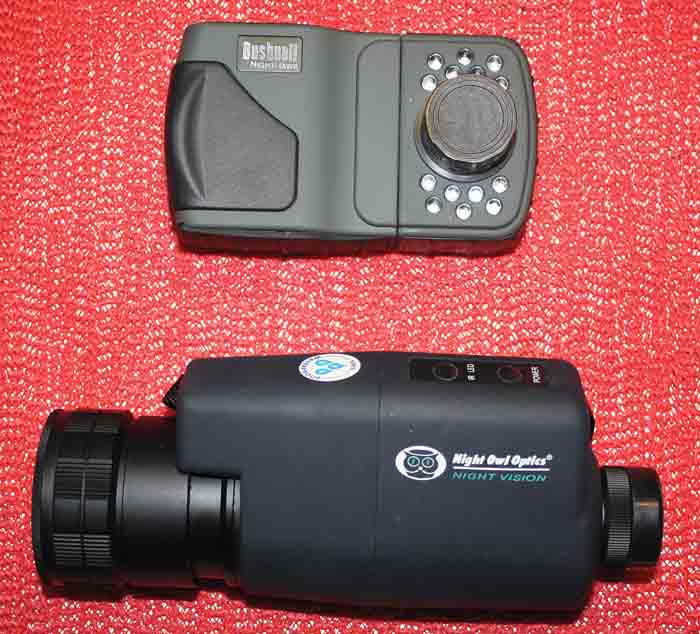
Own the Night
As early as the late 1980s, most real night vision gear was limited to those in uniform and on the silver screen. The units that actually were available were very expensive and of low quality by today’s standards. Concern was always high for units being “liberated” from Uncle Sam because very few outlets were actively marketing them to the civilian side of the industry.
At some point in the early 1990s, imports of foreign night vision technology started to show up on the market. It was extremely inexpensive compared to the real “Mil-Spec” units but the performance matched the pricing. It was far better than nothing and was often the only financially realistic alternative. Some units were very fragile and easily damaged. Others were dangerous to the eyesight of the user. Most of them had spots and the view was quite grainy and most were “observation devices” and not weapon sights.
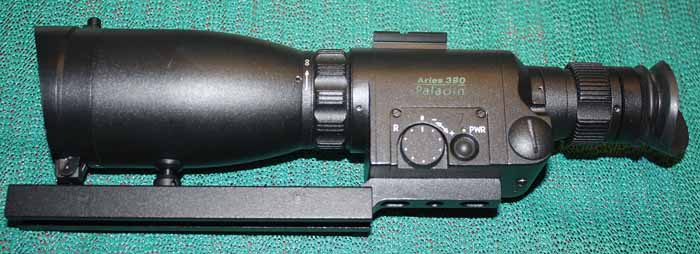
Contrast this to today, when you can walk into a Wall-Mart and buy a reasonably effective monocular for under $200. With the technological advancements we have seen, combined with the explosion of interest in night varmint hunting, there is an abundance of night optics available to sportsmen, ranchers, soldiers and enthusiasts alike. The spectrum in both price and performance is enormous, and there are numerous options available to fit almost anyone’s budget and mission.
The technology and interest in night vision has expanded far beyond the original marketplace and is now quite common in many households and businesses. Most video surveillance systems use infrared lighting and sensitive cameras to have the ability to record in complete darkness. Many hobby-type video cameras even have a night setting to allow the operator to shoot video in complete darkness using integral infrared lighting.
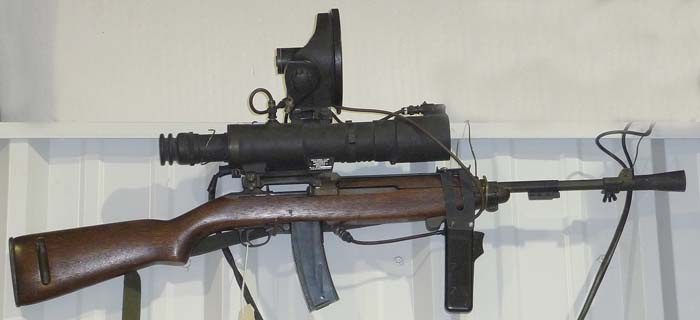
A Shot in the Dark
During the early years when night shooting for civilians was evolving past the interest of only poachers, a common night rifle may have been a firearm, scoped or used with open sights, with a household flashlight duct-taped to the forearm. A visit to a Fisheries and Wildlife confiscated items auction may still show evidence of this crude but somewhat effective method still being employed. As the interest in predator control started to come to the front, inexpensive factory systems were often a scope with a large objective topped with a spotlight and a red lens. The red spectrum of light is said to have a less noticeable negative impact on wildlife than white light, and these systems are still widely used today. With both mechanisms described above, the performance is very limited in distance and clarity but effective enough for some tasks.
For those with a larger budget, or those individuals looking for an increased level of performance, there are several entry-level weapon sights to choose from. What was once almost a “forbidden fruit” in the ultimate accessory category is now manufactured and distributed by several companies with a number of readily available night scopes and accessories.
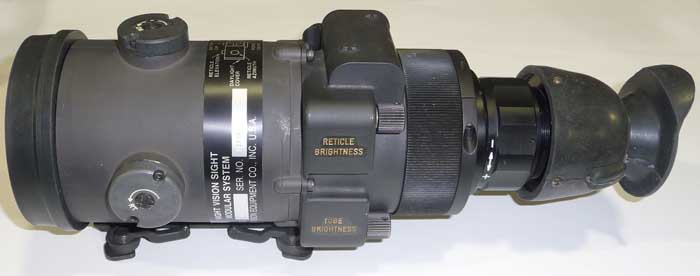
You can easily stay within your budget and balance the price vs. performance for your own situation. Early night vision is pretty impressive stuff until you get behind the latest and greatest, state-of-the-art hardware. It has the chance of being a progressive addiction. Just like you were once happy with your semiautomatic Mini-14 until you fired your buddy’s AC556. The semi was fantastic, but once you experienced the latter, there was no going back. You have several options available:
- Inexpensive commercial foreign optics. Several companies are selling overseas night vision that has been redesigned for U.S. civilian use. These start out around $600 and increase as accessories and upgrades are added.
- Early U.S. Military refurbished units. There are several models of early, once almost unobtainable, military units available today. Though usually large and heavy by comparison to current optics, these can give the owner a lot of bang for the buck. Some people like these for nostalgic reasons as well.
- Current Mil-Spec and Commercial scopes. – Almost everything available to the Military is available on the civilian market. Some are extremely small in size and vary in performance from “not bad” to “crystal clear” but performance comes at a price. The spectrum is very wide in this category with several generations, types and styles available.
- Drop-on, removable, scopes or monoculars. This category of sights is used in conjunction with a normally mounted day scope. Some models mount in front of almost any standard scope and use the regular reticle for aiming. Other models mount behind the day scope. The biggest advantage of these is that you only have to zero your rifle once and can use it day or night since the actual reticle never changes. The night device uses the regular scope for all sighting but allows the shooter to use it at night, like any night scope. The rear-mounted models can be used with dot-style sights (with the day sight / scope in front) but require a special model of sight. If a night monocular were mounted behind a regular “red dot” sight the dot would be far too bright and “flare” the night vision device making it unusable. The author uses two of these special models (EOTech 552 Holograph & Aimpoint Comp M2), which are designed with settings for the dot below the visible spectrum and only viewable with the night scope. There are also standard settings for the reticle that are in the normal, adjustable spectrum. There is a wide range in price and performance with this style of sight.
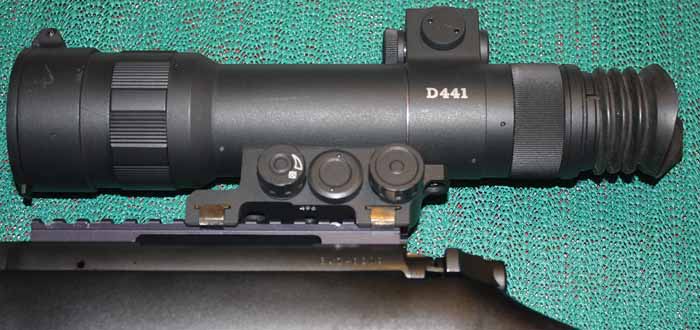
Ready, Aim, FIRE!
Assuming that you do have a night scope or have one coming in, it’s only elemental that before it is time to take on a shooting task with it, you must zero your gun. Some of the older models this writer has used were sighted in during the day using the pinhole lens cover. Some of the later models don’t encourage this practice and we found a tip that makes sighting in on a very dark night a breeze.
Before you do anything, read the manual. The first step in sighting any night vision device is to adjust the diopter setting of the eyepiece of the device to the user’s eye. The moment you hand the night vision device to another operator, he will then have to adjust the eyepiece to his eye. Don’t waste your time doing any other adjustments unless you have correctly set the diopter setting on the eyepiece. To adjust the diopter setting, turn on the night vision device and look towards a blank wall. Adjust the eyepiece till any imperfections in the image tube screen (spots, blemishes, even the reticle) are as sharply focused as possible. When you have accomplished this, you now have your own diopter setting. You should not have to reset the diopter setting of the eyepiece again unless someone else has used the device and moved the setting for their eyesight. Now, you can go outside and adjust for range using the objective lens focus knob for ranging.
Necessity is the Mother of Invention and it once again proved quite true during a recent evening sight-in project. We were shooting on an overcast evening with not a single star in sight and no light from the moon. To compound this, the shooting lane we chose was built in a cultivated Eastern White Pine grove. For those who do not know, the darkest spot on the face of the Earth is at night in a pine grove. The thick groves enclose over the top almost like the canopy of an equatorial rain forest.
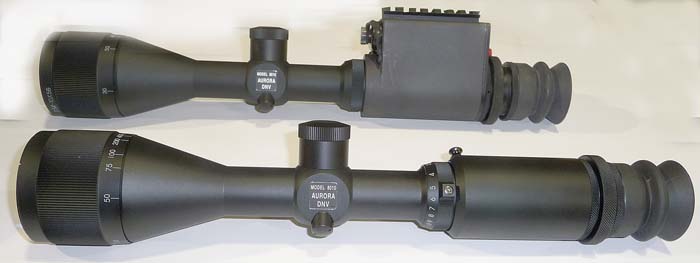
Targets were set as usual and an upcoming project mandated a 100-yard zero, with no room for error. Marksmanship was priority one. At the 100-yard mark in these conditions, the small “bull” was difficult to see because it didn’t reflect enough light to see the difference in the colors (though the target and surroundings were plenty clear) and we wanted some tight “proofing groups” so we wanted the exact, small dot. We took a very small infrared cyalume stick and inserted the end into the bull of the target from the back of the frame. It was not at all visible to the eye but from 100 yards it provided a beautiful dot, dead center in the target.
Sighting commenced with a spotter calling shots and it was obvious when “zero” was attained because each shot would deliver a visible “SPLAT” on the paper target upon impact into the center. This tactic may be in common use and we may not be able to claim it as our own but we have yet to hear of anyone else sighting in this way and thought it was useful enough to pass along here. In the absence of any real IR sticks, a normal green one can be used as long as only a pinhole of light is allowed to light the paper so it won’t resemble a 10-inch sunburst to your optics.
We also found that during a sight-in process a cyalume stick placed out of view behind the target stand makes it very easy for the spotter to pick up the shots. Each new hole will allow a tiny bit of light to penetrate and using a night monocular, it is a fast and easy process.
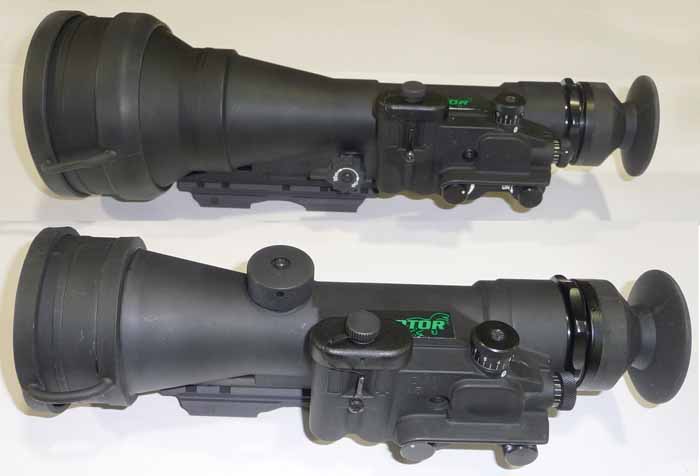
Considerations When Buying a Night Scope
Hopefully this article will help answer some questions that may come up, but there are some specifics you will need to understand when buying a night scope, especially if it is “sight-unseen.”
- Talk to several people who currently use night vision equipment before even calling a dealer. When talking with the dealer make sure you know WHAT you are buying and keep in mind that some dealers you talk to are highly motivated to sell the product that they have available. Some homework on your part can make your experiences with the unit you end up buying much more enjoyable. The terms GEN 0, GEN 1, GEN 2, GEN 2 Enhanced, GEN 3, GEN 3 Enhanced, GEN 4, Mil-Spec, Commercial Grade, High-Intensity, Starlight, Image Intensifier, and several other parts, grades and descriptions will cross your path. Make sure you and the dealer are certain what you are buying is what you THINK you are buying.
- Battery life and battery type are extremely important. Older and foreign units often used non-conventional batteries by today’s standards. Some even used an exterior battery pack. Many of the older optics have been converted to use common batteries. Each unit is also different in the amount of time you have with a single load of fresh batteries. The use of a built-in IR illuminator will quickly draw your batteries down over the use of natural light shooting. Battery life is something that should be included on many spec-sheets and will be an easy answer for the dealer. Most modern units available today tend to use AA batteries and some units are going to the 123 battery type. Lithium batteries will perform much better than standard alkaline batteries and are well worth the additional expense.
- The operating temperature range can be extremely important depending on the conditions you wish to function in. This writer lives in Maine and 0º F is a “normal” temperature in the winter so a scope made for desert conditions may not be very practical in this situation. While only extremely hot or cold climates may have adverse effects on the performance, the major problem of running ANY electronic equipment in extremely cold environments is the reduced operating life of the batteries. Buy good ones and carry plenty of spares. Since we are on the topic of temperature, you need to be aware of proper storage procedures. This isn’t as much of a pre-purchase concern but would be doing a disservice if we didn’t mention this; NEVER store your night vision in the trunk of your car! Temperatures above 125 degrees can destroy the hermetic seal within the image tube.
- Your depth perception is not available when using night vision equipment. The view is not really a singular-dimensional one but it is also not the same as using your regular optics, or no optics at all. The view is similar to watching a TV screen.
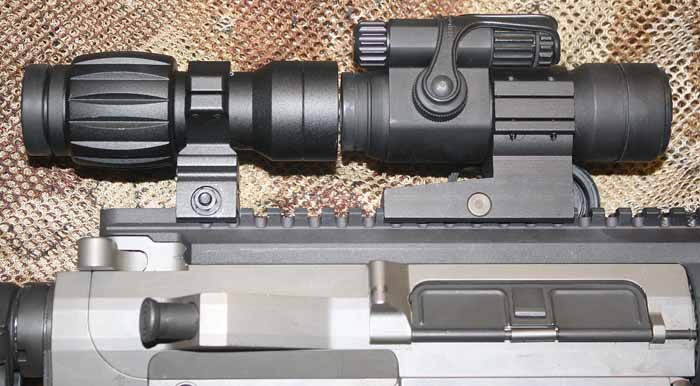
The Star of the Show Thermal Imaging Devices
As previously mentioned, night vision can be a progressive hobby. At the top of the heap, on a throne all by itself sits the holy grail of the Night Vision world: the Thermal Imaging Device. Although these can cost several times the price of the previously discussed devices there are several distinct advantages.
Just like the night vision devices we have covered so far, a thermal imaging sight also uses infrared technology. The major difference between traditional night vision and thermal imaging is the wavelength of infrared light being viewed. Unlike those that enhance the image by gathering and processing much more white light and “near infrared” light than the naked eye can see and converting it into a visible picture, thermal imaging is used to view farther into the non-visible infrared light spectrum. This unit detects the infrared (or heat) wavelengths that are being emitted by the objects you are viewing instead of viewing the infrared spectrum of light that is being reflected off the objects when using an image intensified device.
Everything emits infrared light and energy and the light frequency changes with the amount of temperature being emitted. As energy is emitted from an object in the form of heat, the hotter it is, the more infrared energy it releases. When viewing something using thermal technology, when something is hotter than the objects or area around it, it will appear to be glowing brightly and is easily identified, even in the darkest situations.
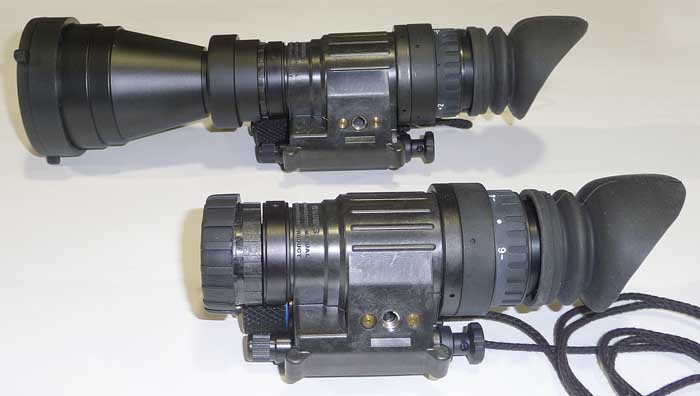
For the purposes of understanding the differences between your normal vision, traditional night vision and thermal, it is important to remember how camouflage works. Camouflage is simply having the ability to blend in with your surroundings, regardless of the means. Most people reading SAR have some experience with the use of camouflage, whether it is military service, law enforcement, hunting, paintball games or numerous other situations. Animals use camouflage in order to survive from predators by blending into their surroundings. Camouflage does not necessarily mean a green woodland pattern, but any pattern, shape, color (and combination of all of them) to blend into the immediate environment. One may blend into the woods well with a leafy pattern similar to the colors of the specific season, while the same person would blend in better in a shopping mall with jeans and a baseball cap. Again, it is the art of blending in to the current environment.
Most people who hunt know how well camouflage works in the animal kingdom. It is easy to walk up on or directly past a deer in the woods without seeing it before it sees you. This is no different at night. Since a person, animal or object that is well camouflaged during the day can escape your sight, the same happens at night with traditional night vision equipment. A target hiding in a hedgerow can go undetected in both situations if he is still and well blended until thermal technology is used since he can’t control the heat he naturally emits.
When looking through a thermal imaging device you are seeing a whole new world. It is not as picturesque or detailed as your natural eyes show you, but there is an amazing amount of information we don’t have the ability to process on our own. A nice thermal imaging unit can detect differences in heat as low as 1/2º F or lower. The hotter an item is, the brighter it is to the viewer.
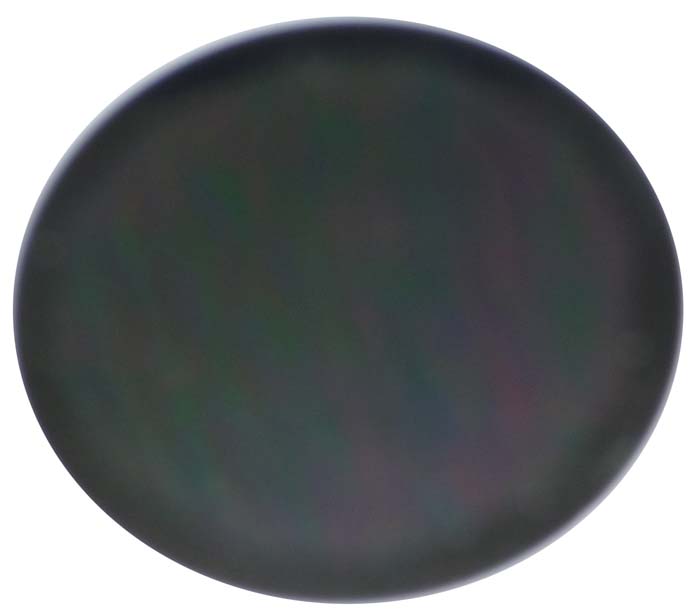
With the availability of thermal technology there is no longer any place to hide. This has many applications in many fields. If a hunter is looking for a wounded or killed animal, a blood trail will glow like a trail of bright light, as will the animal for several hours. If a policeman is looking for a car that was noted to have pulled into a 1,000-car auto dealership at night, it will shine like the sun compared to the others that have not been running. If a fireman is looking for “hot spots” in a burning building, the fire will show up through the closest walls like they are invisible. If a homeowner wants to “button up” a house to see where heat loss problems are, they will be immediately obvious looking through a thermal unit. Thermal imaging is sensitive enough to see where someone spit or simply laid their hand for only seconds. What it will show you is nothing short of amazing but it is also important to understand what it will not show you.
–The Fight for the Night–
Image Intensified Passive IR Devices vs. Thermal Devices
There is an extreme amount of difference between the sight you see using these devices. No one should argue that either unit provides an amazing advantage over our natural eyesight, but the images are very different. In the “You can not hide” category, the win is in the thermal column in this writer’s opinion. (Note: Thermal devices can’t “see” through glass or water! Instead the glass will act like a mirror.)
When it comes to identifying specifics in a night location the win goes to the Passive IR in the “I see what’s in your hand” category. While the thermal imaging devices show the user the location of well-hidden objects, the detail is very low in resolution compared to the Passive IR devices. With most of the traditional night scopes the subjects are viewed in their normal state, just in a shade of green or grey depending on the device. Some of the latest units are extremely clear and reading a license plate, or identifying non-animate objects is not only possible but also done with ease. These details are lost on the thermal imaging units as they only show emitted heat/light and not detailed surroundings.
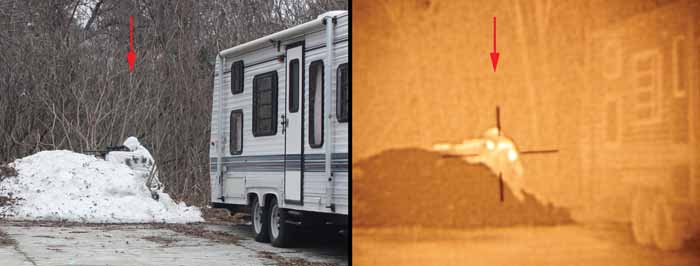
After spending plenty of time with several devices, it is the opinion of this writer that both types of units have their own clear advantages and the use of both units together create an unbelievable advantage with all the bases covered. For specific projects one may be immediately beneficial over the other but none can be declared a hands-down winner.
Accessories Galore
There are several useful accessories available for whatever type of device you are using. You can buy numerous items to enhance the scope of what you can do with these such as IR Lasers (which are strictly regulated by the F.D.A and can only be sold legally to an official “approved” Government agency, or U.S. Military purchase order or “approved” certified law enforcement agency), IR illuminator lights, IR lens adapters for common flashlights and flood lights, magnification adapters, camera adapters, several mounting options and much more.
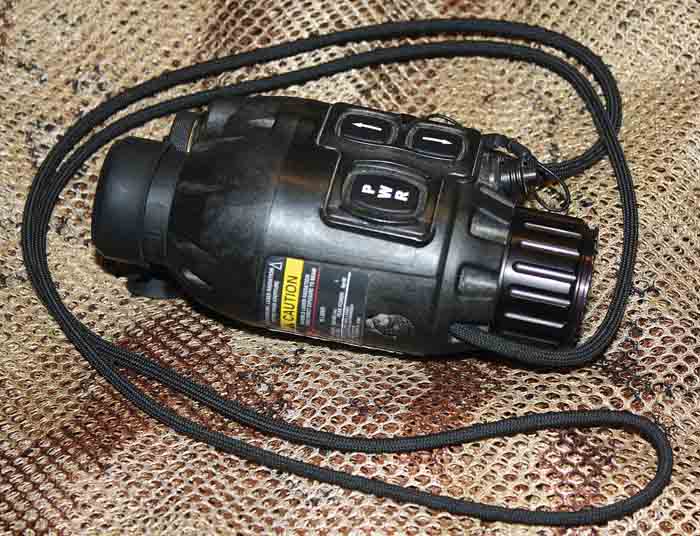
Conclusion
At this time there is a night device that will fit almost every budget and project. If you work in hostile environments or in public safety you are at a disadvantage if you don’t use these items. For those individuals with a little more expendable income there are some fascinating items that can be purchased and allow you the latest technology available today. If your budget is more moderate, the number of items available to you is almost unlimited. There is no need to mortgage the farm to get a night vision scope or device to fill your needs. As time goes on the later technology should fall into line at some point, but there is no need to wait for the latest and greatest. As mentioned previously, this is an addictive and evolving place of interest and once you can see and shoot effectively at night there is no going back. No matter which device you start with it is an amazing and exciting field. Just do your homework, ask lots of questions to people who use this gear and prepare to submerge yourself in a whole new aspect of the shooting world. Also make sure to check your local and state laws about the capacities in which you can use these devices.
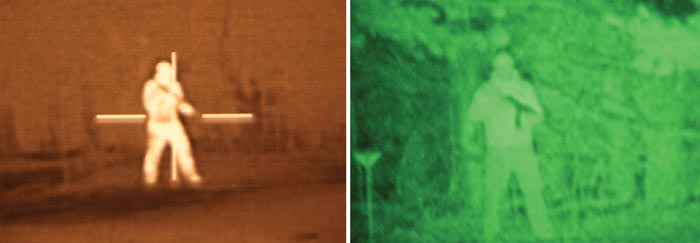
The author would like to thank Rich Urich, VP Operations with Aurora Tactical, for his technical assistance in this article. Aurora Tactical can be reached by email via their website at: www.auroratactical.com and have several variations and brands of devices available as well as a lot of useful information.
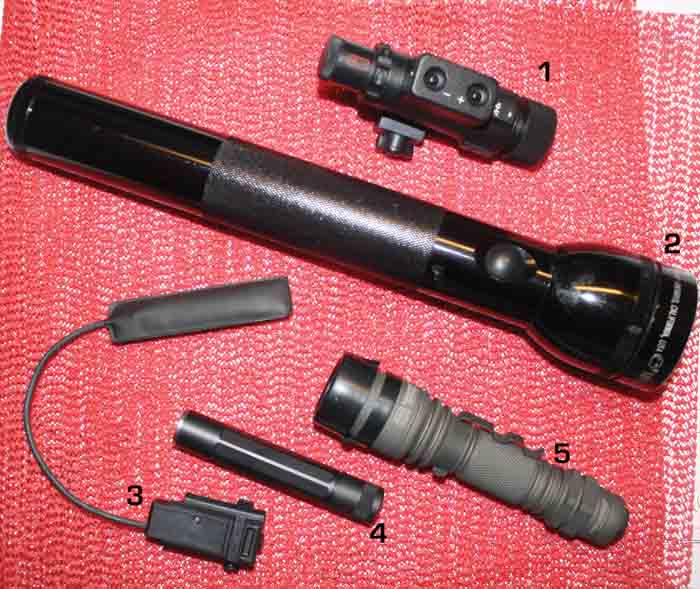
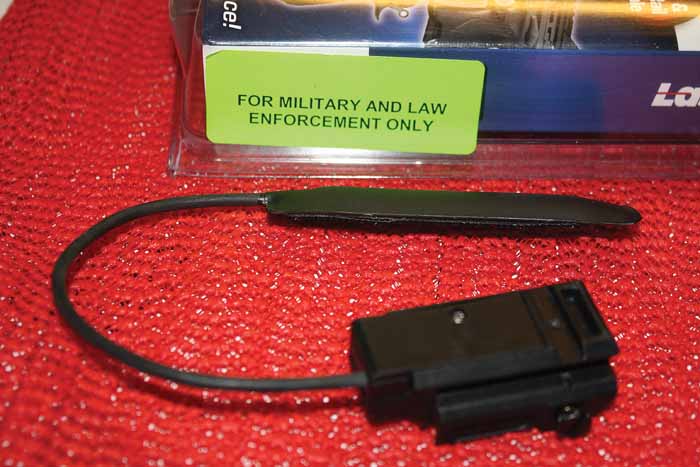
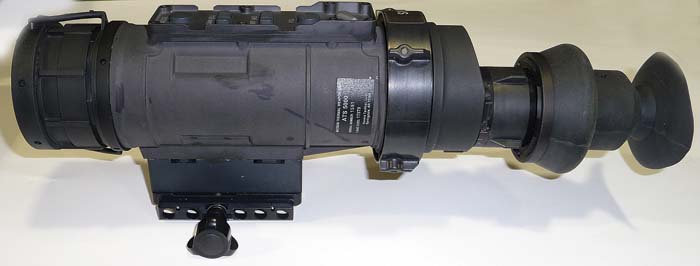
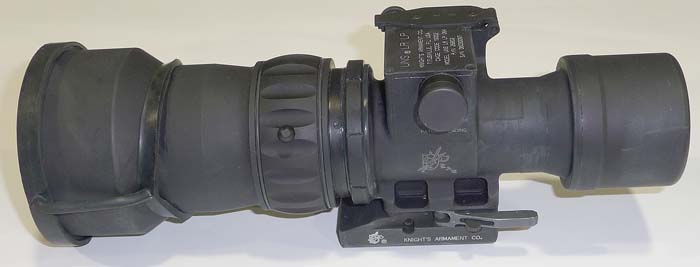
| This article first appeared in Small Arms Review V13N9 (June 2010) |











